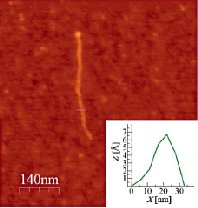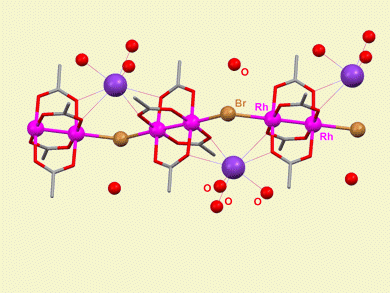The trend to smaller and smaller electronic devices depends on the ability to reproduce the macroscale wires and switches of electric devices on a microscale for the electronic counterparts. Wires are made of many metal atoms linked together in a way that allows the passage of electrons. The thinnest conceivable wire is a string of metal atoms linked together with metal-metal bonds or through other atoms that can also transmit electrons. On the molecular scale such strings of atoms are not stable without a surrounding protection to prevent chemical reaction breaking up the chains.
It is a challenge to create long conducting chains of atoms.
Reyes Jiménez-Aparicio, University of Madrid, and colleagues have synthesized infinite chains of pairs of rhodium atoms protected by four carboxylato groups and linked by halogen atoms (Kx[Rh2X(O2CCH3)4]x•4xH2O) in a simple procedure in water, without the need for inert atmosphere. When the halogen atom is chlorine and the rhodium atom pair is partially oxidised, the [Rh2Cl(O2CCH3)4]x chains are linear. The researchers also showed that these molecular wires are conductive.
The uncomplicated preparation of infinite, conducting Rh2X wires represents a breakthrough for 1-D chain compounds and bimetallic chemistry.
 AFM topographic image of the fibre of complexe 2·4H2O adsorbed on mica.
AFM topographic image of the fibre of complexe 2·4H2O adsorbed on mica.
- MMX Chains and Molecular Species Containing Rh2n+ (n = 4, 5, and 6) Units: Electrical Conductivity in Crystal Phase of MMX Polymers
P. Amo-Ochoa, R. Jiménez-Aparicio, M. Rosario Torres, F. A. Urbanos, A. Gallego, C. J. Gómez-García,
Eur. J. Inorg. Chem. 2010.
DOI: 10.1002/ejic.201000741




